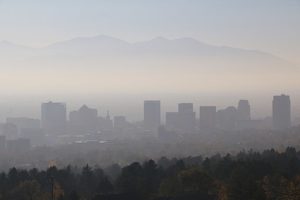Defining Safety Levels for Particulates Could Hurt Your Health – and the Economy
 You’ve probably heard about some of the recent changes from the Environmental Protection Agency (EPA). But you might have missed the proposal about particulate matter (PM), since it didn’t get as much press. Or even if you saw it, you might not have recognized all the implications because they’re not immediately obvious.
You’ve probably heard about some of the recent changes from the Environmental Protection Agency (EPA). But you might have missed the proposal about particulate matter (PM), since it didn’t get as much press. Or even if you saw it, you might not have recognized all the implications because they’re not immediately obvious.
This proposal is to define a safety threshold for what’s called PM 2.5, and it’s a reversal of the EPA’s prior stance. Until recently, the EPA said that no amount of particulate matter can be considered safe. Changing that could have serious impacts on our health – and the economy.
What is PM 2.5, and where does it come from?
Even if you’ve never heard of particulates, you’re likely familiar with them. These are the fine particles of liquids and solids that contribute to haze-filled cities and poor air quality. In fact, another name for PM is particle pollution.[1] This is because the tiny size allows these particles to get everywhere – including deep in your lungs.
PM 2.5 is a specific kind, named because the particles are only 2.5 micrometers in size. For comparison, an average human hair is 75 micrometers in width.[2]
These tiny materials are everywhere, coming from a number of places, including cigarettes and fireplace smoke. But the vast majority come from two sources:
– 50% is from industrial production, with 20% of that from coal-powered plants
– 35% is from gas-powered vehicles of all kinds[3]
Costs and benefits with current policy
Under the current policy, with no level of particulate matter considered “safe,” any reduction of PM 2.5 below current levels is considered a benefit, and can be included in federal cost-benefit analyses.
In other words, if regulations to reduce greenhouse gases simultaneously reduce PM 2.5 (as they would, given that they share many of the same sources), that reduction counts as a co-benefit. And those co-benefits can play a significant role in the cost-benefit analysis of any proposed regulation to reduce greenhouse gases.
For example, the Clean Power Plan from the Obama era had an estimated $20 billion in climate benefits. But the benefits go up when you consider that the same technology used to reduce power plant emissions would also cut PM levels. Those changes result in an additional $13 to $30.3 billion in health benefits, effectively doubling the benefits.
Similarly, the Mercury and Air Toxics standards save $4 to $6 million by reducing toxins. And in this case, the co-benefit from reducing particulates is even higher, coming in between $37 and $90 billion.[4]
Proposed change reduces benefits
Now, under the proposed changes, lowering PM levels below the suggested “safety levels” won’t count as a benefit. After all, if anything below the threshold is already considered safe, bringing it down even further won’t be helpful.
This means that moving forward, climate change initiatives like the Clean Power Plan wouldn’t be able to factor in the lower levels of PM 2.5. And without that, the initiative might not get implemented, because the cost would be considered too high without the co-benefit to offset it.[5]
Damages from air pollution
The impact on regulations is a concern, but those aren’t the only considerations. Air pollution already causes damages between $75 and $230 billion annually. And PM 2.5 contributes more to that than their size indicates.
Even though these particulates only account for 6% of emissions by weight, they cause 23% of the damages. The damages from PM 2.5 alone are between $17.25 and $52.9 billion annually. [6]
Health and economic impact
Most of the economic damage caused by PM 2.5 is due to increased health costs.[7] Health issues associated with PM 2.5 include:
– Respiratory illnesses like bronchitis
– Premature death
– Low birth weight
– Higher risk of asthma
– Greater risk of heart disease
– More instances of lung cancer
These conditions all carry increased economic cost. Some of this is a result of increased medical care, such as hospital visits and medication. [8]
But the costs also come from lost work time and reduced productivity. People who need to take time off for appointments and medical care won’t be as effective. Similarly, those who can’t breathe as well have less energy and will be less productive, even if they don’t require urgent care.
In addition, since particulates contribute to poor air quality, people might be more likely to stay inside. This means lost revenue from outdoor recreation and the potential of reduced health from lower levels of activity.
Poor air quality actually could have a negative impact on region’s workforce. Putting a priority on quality of life is becoming more common – including looking at factors like air quality. If an area has a distinct haze, or higher levels of respiratory conditions, people may choose to leave, or to not move there to begin with.[9]
Conclusion
While it’s impossible to identify all the effects of the EPA’s proposed safety threshold, it’s clear that the negative impacts could be far-reaching. Given that, the EPA and other agencies should take all of the risks into account before accepting a change that could cause such extensive damages to our environment, our health, and our economy.
Photo Credit: Eltiempo10 [CC BY-SA 4.0], from Wikimedia Commons
[1] https://airnow.gov/index.cfm?action=aqibasics.particle
[2] http://www.sciencemag.org/news/2018/08/kill-climate-rule-trump-s-epa-wants-redefine-danger-soot
[3] http://www.rff.org/blog/2007/what-do-damages-caused-us-air-pollution-cost
[4] http://www.sciencemag.org/news/2018/08/kill-climate-rule-trump-s-epa-wants-redefine-danger-soot
[5] Ibid
[6] http://www.rff.org/blog/2007/what-do-damages-caused-us-air-pollution-cost
[7] Ibid
[8] https://www.brookings.edu/blog/jobs/2011/05/06/we-are-what-we-breathe-the-impacts-of-air-pollution-on-employment-and-productivity/
[9] https://www.forbes.com/sites/quora/2018/05/29/how-the-air-quality-where-you-live-might-be-affecting-your-health/#2881f8b37017